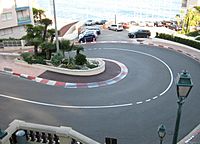Circuit de Monaco facts for kids
 Grand Prix Circuit Grand Prix Circuit |
|
| Location | Monte Carlo, Monaco |
|---|---|
| Time zone | UTC+01:00 |
| Capacity | 37,000 |
| FIA Grade | 1 |
| Major events | Formula One Monaco Grand Prix Formula Two Monaco Grand Prix Formula E Monaco ePrix (odd numbered years) Historic Grand Prix of Monaco (even numbered years) |
| Grand Prix Circuit (2015–) | |
| Length | 3.337 km (2.074 mi) |
| Turns | 19 |
| Race lap record | 53.822 (Sam Bird, DS Virgin Racing, 2017) |
| 5th variation (2003–2014) | |
| Length | 3.340 km (2.075 mi) |
| Turns | 19 |
| Race lap record | 1:14.439 (Michael Schumacher, Ferrari, 2004) |
| 4th variation (1997–2002) (Redesigned swimming pool section) | |
| Length | 3.370 km (2.094 mi) |
| Turns | 25 |
| Race lap record | 1:18.023 (Rubens Barrichello, Ferrari, 2002) |
| 3rd variation (1986–1996) (Nouvelle chicane added) | |
| Length | 3.328 km (2.068 mi) |
| Turns | 25 |
| Race lap record | 1:21.076 (Michael Schumacher, Benetton-Ford, 1994) |
| 2nd variation (1976–1985) (Using smaller, faster Chicane du Port) | |
| Length | 3.312 km (2.058 mi) |
| Turns | 23 |
| Race lap record | 1:22.637 (Michele Alboreto, Ferrari, 1985) |
| 1st variation (1973–1975) | |
| Length | 3.278 km (2.037 mi) |
| Turns | 20 |
| Race lap record | 1:27.9 (Ronnie Peterson, Lotus-Ford, 1974) |
| Original circuit (1929–1972) | |
| Length | 3.145 km (1.954 mi) |
| Turns | 14 |
| Race lap record | 1:22.2 (Jackie Stewart, Tyrrell-Ford, 1971) |
| Formula E circuit (2015–) | |
| Race lap record | 53.822 sec (Sam Bird, Virgin, 2017) |
The Circuit de Monaco is a famous street circuit. It is built right on the city streets of Monte Carlo in Monaco. People often call it "Monte Carlo" because it runs through that area.
This special track is used for races on two weekends each May. It hosts the exciting Formula One Monaco Grand Prix. It also hosts the Formula E Monaco ePrix in odd-numbered years. In even-numbered years, it hosts the Historic Grand Prix of Monaco. Other racing series, like Formula Two, also race here.
History of the Circuit de Monaco
The idea for a Grand Prix race in Monaco came from Antony Noghès. He was the head of the Monegasque motor club, the Automobile Club de Monaco. He was also a close friend of Monaco's royal family.
The very first race was held in 1929. It was won by William Grover-Williams driving a Bugatti car.
What Makes the Circuit Special?
Building this circuit takes about six weeks. Taking it down after the race takes another three weeks. The track has many changes in height and very tight corners. It is also quite narrow. These features make it one of the most challenging tracks in Formula One racing.
Even though the course has changed over the years, it is still a true test of a driver's skill. It has the slowest corner in Formula One, called the Fairmont Hairpin. Cars go through it at about 48 kilometers per hour (30 mph). It also has one of the fastest parts, a flat-out bend in the tunnel. Cars can reach 260 kilometers per hour (160 mph) there.
Because the circuit is so tight and twisty, driver skill is more important than car power. However, it is very hard to pass other cars here. The track is simply too narrow and difficult. The famous tunnel section runs under the Fairmont Hotel. Drivers find it tricky because they go from bright light to dark, then back to light very quickly. This happens at one of the fastest parts of the track.
The Circuit de Monaco is known for being a very demanding track. It is a unique challenge for drivers. In January 2009, it was even voted one of the "Seven Sporting Wonders of the World."
Images for kids
See also
 In Spanish: Circuito de Mónaco para niños
In Spanish: Circuito de Mónaco para niños









